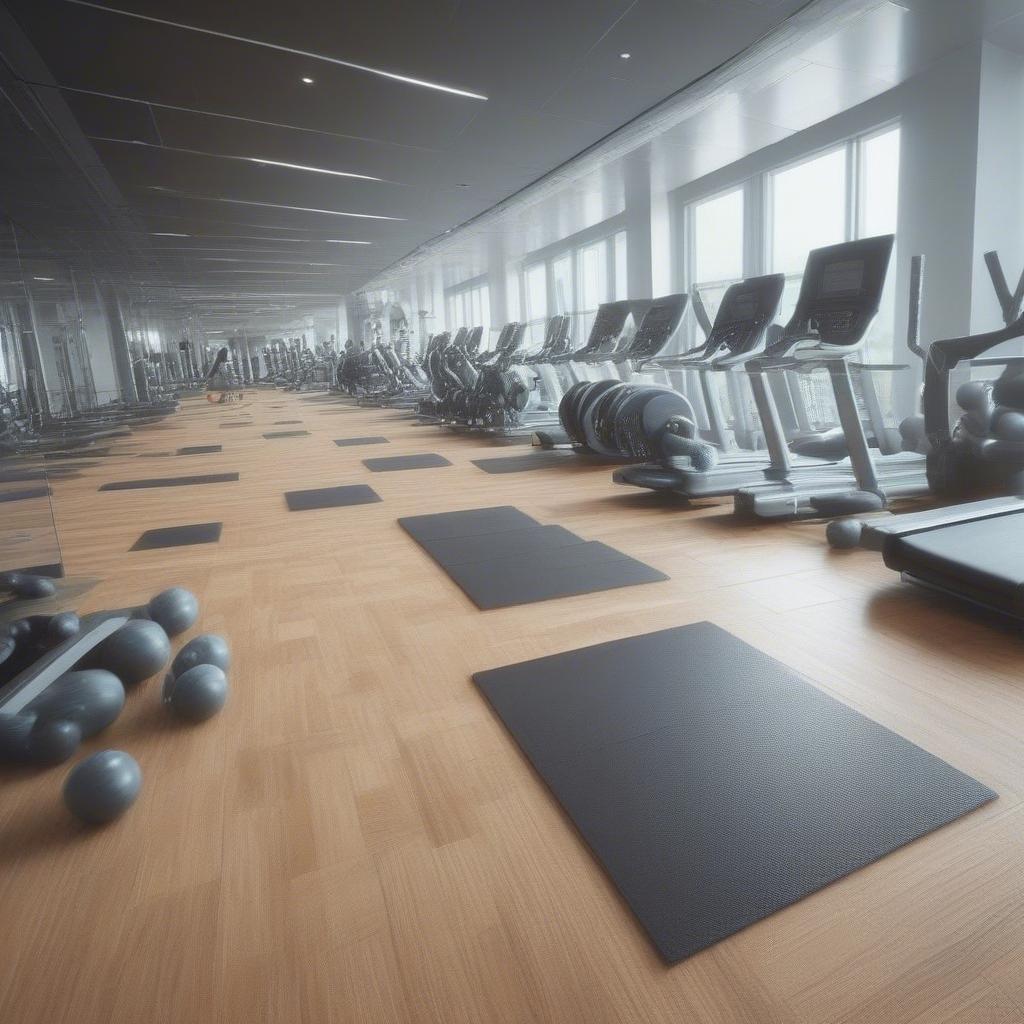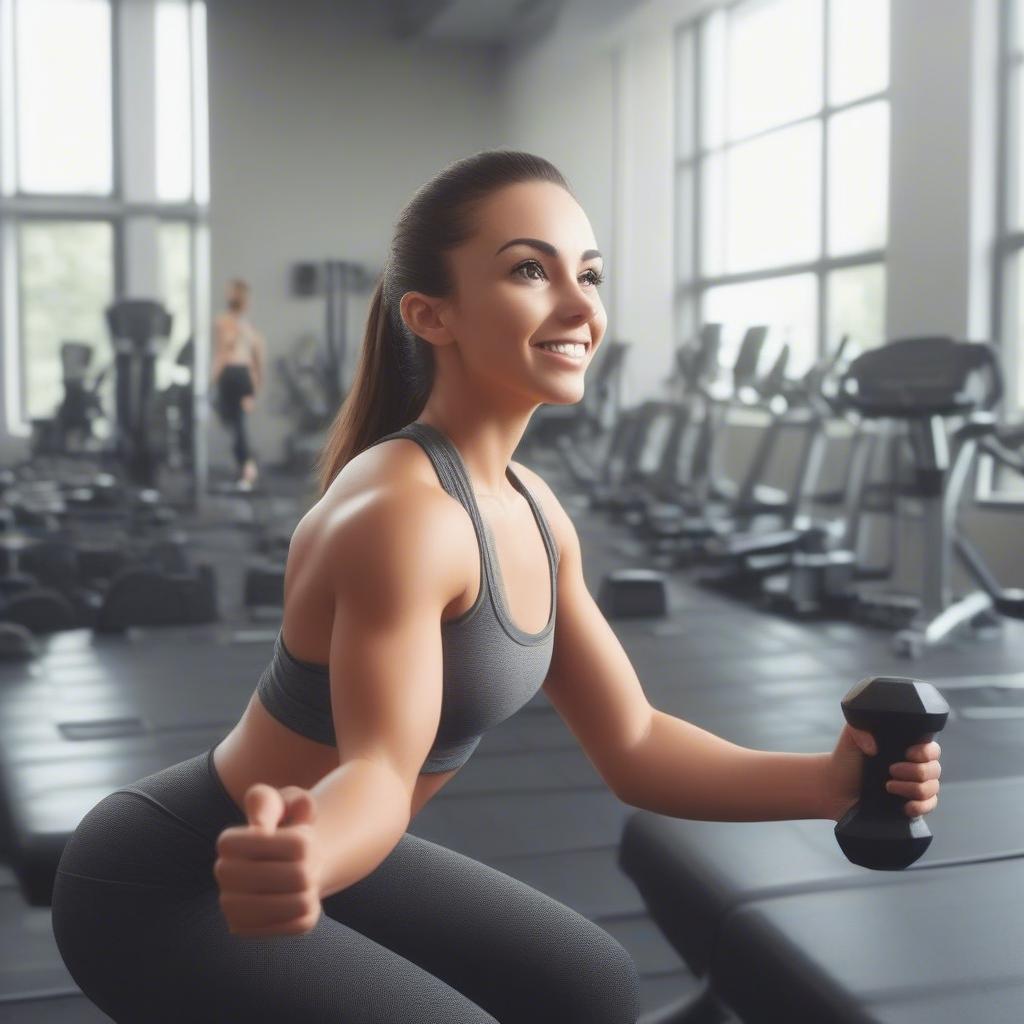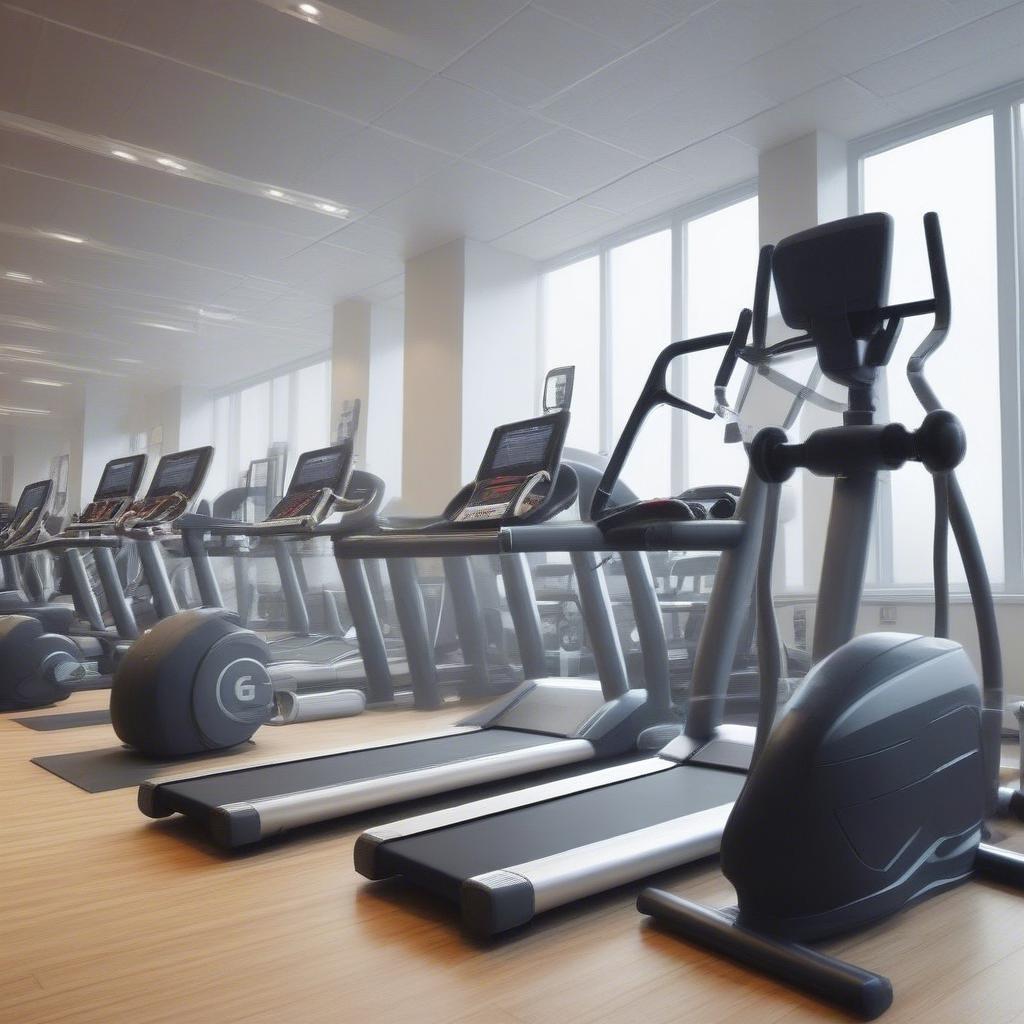
Choosing the right gym flooring is more than just an aesthetic decision; it’s a crucial investment that impacts safety, performance, and the overall success of your fitness space. Whether you’re setting up a home gym or managing a large commercial fitness center, understanding the options is paramount. This guide will help you navigate the world of best gym surfaces, ensuring you select the perfect flooring for your specific needs.
Why the Right Gym Flooring Matters
Before diving into the specifics of different types of gym flooring, let’s understand why this choice is so critical:
Safety First: Preventing Injuries
- Impact Absorption: The right flooring absorbs impact, reducing stress on joints and preventing injuries like ankle sprains or knee problems.
- Slip Resistance: A textured surface or material designed for traction can prevent slips and falls, especially during intense workouts.
- Stability: Proper flooring provides a stable base for weightlifting and dynamic movements, reducing the risk of accidents.
Performance Enhancement
- Grip and Traction: Optimal grip ensures secure footing for squats, lunges, and other exercises.
- Energy Return: Certain flooring materials offer energy return, helping you maintain momentum during workouts.
- Noise Reduction: Good flooring can minimize noise, creating a more pleasant workout environment.
Protecting Your Investment
- Durability: High-quality gym flooring withstands heavy weights, constant foot traffic, and impacts without damage.
- Ease of Maintenance: Some surfaces are easier to clean and maintain, saving you time and money in the long run.
- Long-Term Cost-Effectiveness: Investing in durable flooring prevents the need for frequent replacements, saving money in the long run.
Creating the Right Atmosphere
- Aesthetics: The look and feel of your flooring can enhance the overall ambiance of your gym.
- Branding: Choosing colors and styles that align with your brand can reinforce your identity.
- Motivation: A welcoming and well-designed space can increase motivation and encourage consistency.
Types of Gym Flooring: A Comprehensive Overview
The best gym surfaces vary dramatically, and understanding their unique attributes is essential for making the right selection. Here’s a detailed breakdown of common options:
Rubber Flooring
Rubber flooring is a popular choice for gyms due to its durability and versatility.
Rubber Mats
- Description: These are typically thick, individual tiles or mats made from recycled or virgin rubber.
- Pros:
- Excellent Impact Absorption: Rubber mats are excellent at cushioning impacts and reducing stress on joints.
- Easy Installation: They are often designed to interlock, making installation quick and simple.
- Portable: They can be moved and rearranged as needed.
- Durable: They withstand heavy use and are resistant to wear and tear.
- Cost-Effective: Generally more affordable than other options.
- Cons:
- Can Be Heavy: Some mats can be cumbersome to move.
- Less Aesthetic: May not be as visually appealing as other options.
- Can Have an Odor: Some rubber mats have a strong odor, especially when new.
- Best For: Weightlifting areas, functional training zones, home gyms, and areas where mobility is important.
Rubber Rolls
- Description: Sold in rolls, these provide a seamless surface, often covering large areas.
- Pros:
- Seamless Appearance: Provides a clean and professional look.
- Easy to Clean: Smooth surface makes cleaning easy.
- Customizable: Can be cut to fit specific spaces.
- Great for Large Spaces: Suitable for larger commercial fitness center floors.
- Impact Absorption: Provides adequate cushion for most activities.
- Cons:
- More Difficult Installation: Can be more challenging to install compared to mats.
- Less Portable: Not designed to be easily moved.
- Potential for Buckling: If not properly installed, it can buckle.
- Best For: Large areas, cardio zones, group fitness classes, and commercial gyms.
Foam Flooring
Foam flooring is a softer option, ideal for activities that involve a lot of floor work.
EVA Foam Tiles
- Description: Made from ethylene-vinyl acetate, these are often puzzle-piece style tiles.
- Pros:
- Soft and Comfortable: Provides a cushioned surface that is gentle on joints.
- Lightweight: Easy to install and move around.
- Affordable: Generally cheaper than rubber flooring.
- Variety of Colors: Available in various colors and patterns.
- Good for Children: Safe and soft for kids’ activities.
- Cons:
- Less Durable: Not as durable as rubber, prone to tearing with heavy weights.
- Not Ideal for Heavy Lifting: Can be too soft for activities with heavy equipment.
- Difficult to Clean: Can be difficult to clean spills.
- Best For: Yoga, Pilates, stretching areas, kids’ play areas, and light workout zones.
High-Density Foam
- Description: This is a more durable version of foam flooring designed for higher-impact activities.
- Pros:
- Greater Durability: More resilient than standard EVA foam.
- Good Impact Absorption: Provides excellent shock absorption.
- Comfortable: Softer than rubber, making it suitable for various exercises.
- Cons:
- More Expensive: Usually costlier than standard EVA foam.
- May Not Be Suitable for Very Heavy Lifting: Not designed for extremely heavy weights.
- Less Durable than Rubber: While more durable than EVA, not as strong as rubber.
- Best For: HIIT workouts, plyometrics, bodyweight exercises, and areas that need a blend of comfort and durability.
Carpet Tiles
Carpet tiles are a less traditional choice for gyms but can be suitable for specific needs.
- Description: Individual squares of carpet that can be installed to cover a floor.
- Pros:
- Comfortable: Provides a warm, comfortable feel.
- Noise Reduction: Excellent at minimizing sound.
- Variety of Designs: Available in numerous patterns and styles.
- Easy to Replace: Individual tiles can be replaced if damaged.
- Cons:
- Less Durable: Prone to wear and tear under heavy use.
- Harder to Clean: Can trap dirt, sweat, and odors.
- Not Ideal for Heavy Weights: Can become compressed under heavy equipment.
- Best For: Low-impact areas like stretching zones, yoga studios, and personal training studios with low impact activities
Turf Flooring
Turf flooring is a great option for athletic training and functional movement.
- Description: Synthetic grass-like flooring, often used in athletic training facilities.
- Pros:
- Realistic Feel: Mimics the feel of natural grass, great for sports training.
- Durable: Can withstand heavy use and outdoor conditions.
- Versatile: Suitable for a range of activities like sled pushes, agility training, and functional movements.
- Cons:
- Higher Cost: Typically more expensive than other gym flooring options.
- Can Be Hard to Clean: Can require special cleaning tools and products.
- Not Suitable for Weightlifting: Can become damaged if used for heavy weightlifting.
- Best For: Functional training zones, athletic training, sled work, and agility drills.
Vinyl Flooring
Vinyl flooring is a durable and easy-to-maintain option, often seen in commercial gyms.
- Description: Available in planks or rolls, it offers a smooth and resilient surface.
- Pros:
- Durable: Resistant to scratches, stains, and dents.
- Water-Resistant: Easy to clean and maintain.
- Versatile Design Options: Available in numerous styles and patterns.
- Cost-Effective: Generally less expensive than hardwood.
- Cons:
- Less Impact Absorption: Not as good at absorbing impact as rubber or foam.
- Can Be Slippery: May become slippery when wet.
- Not Ideal for Weightlifting: May not be the best choice for areas with heavy weights.
- Best For: Cardio areas, group fitness studios, and light workout spaces.
Wood Flooring
Wood flooring is aesthetically pleasing, but its suitability for gyms depends on the type of wood and finish.
- Description: Hardwood or engineered wood planks that can provide a traditional look.
- Pros:
- Aesthetically Pleasing: Adds a touch of elegance to any space.
- Durable: Can last a long time with proper care.
- Smooth Surface: Ideal for dance or aerobic classes.
- Cons:
- Expensive: Costly to install and maintain.
- Less Durable Than Other Options: Can be easily scratched or dented.
- Prone to Damage from Water and Sweat: Requires special care and maintenance.
- Less Impact Absorption: Does not absorb impact as well as other flooring types.
- Best For: Dance studios, aerobics classes, and low-impact workout spaces.
Choosing the Right Flooring: A Step-by-Step Guide
Selecting the ideal best gym surfaces for your needs requires careful consideration and planning. Here’s a step-by-step guide to assist you:
Step 1: Define Your Gym’s Purpose
- What activities will take place? Will your gym be for weightlifting, cardio, yoga, functional training, or a combination of these?
- What types of equipment will be used? Will there be heavy weights, treadmills, stationary bikes, or other equipment?
- Who will be using the space? Will it be used by children, adults, athletes, or people with mobility issues?
- How large is the area? Knowing your space’s dimensions will help you select the appropriate quantity of materials.
Step 2: Assess Your Needs
- Safety Requirements: Identify the level of impact absorption, slip resistance, and stability you require.
- Durability Needs: Consider how much wear and tear the floor will endure and choose a material that can withstand it.
- Maintenance Needs: Decide how much time and effort you are willing to invest in cleaning and maintenance.
- Budget: Determine your budget to narrow down the range of options.
- Aesthetic Preferences: Choose a flooring style that aligns with your brand and creates the atmosphere you desire.
Step 3: Research and Compare Options
- Read Reviews: Look at reviews of different types of flooring and compare the pros and cons.
- Get Quotes: Obtain quotes from various suppliers to compare prices.
- Order Samples: Get samples of different flooring materials to test and see what works best.
- Visit Showrooms: Check out local flooring showrooms to view options in person.
Step 4: Make Your Selection
- Balance Your Priorities: Consider what is most important to you—safety, durability, budget, or aesthetics—and prioritize accordingly.
- Choose the Right Materials: Select materials that meet your needs and match your gym’s purpose.
- Factor in Installation: Decide whether you will install the flooring yourself or hire professionals.
Step 5: Plan Your Installation
- Prepare the Subfloor: Ensure the subfloor is level and clean before installation.
- Measure Carefully: Measure the space accurately to ensure you have enough materials.
- Follow Instructions: Carefully follow the installation instructions for the chosen flooring material.
Step 6: Maintenance and Upkeep
- Regular Cleaning: Establish a routine cleaning schedule to maintain your flooring.
- Use Appropriate Cleaning Products: Select cleaning products that are safe for your specific flooring type.
- Inspect Regularly: Inspect your flooring for any damage or wear and tear.
- Make Repairs as Needed: Repair any damage promptly to prevent further issues.
Practical Examples and Scenarios
Let’s consider some practical scenarios to illustrate the importance of selecting the right gym flooring:
Home Gym for Weightlifting and Cardio
- Needs: High impact absorption, slip resistance, and durability for heavy weights and cardio equipment.
- Best Choice: Rubber mats or interlocking tiles for the weightlifting area and rubber rolls or vinyl flooring for the cardio space.
- Why: Rubber mats offer excellent protection for lifting weights while rubber rolls or vinyl provide easy-to-clean options for cardio workouts.
Commercial Fitness Center with Group Classes
- Needs: Durability, easy to clean, good for high foot traffic, suitable for a variety of exercises.
- Best Choice: Rubber rolls or vinyl flooring in main workout areas, foam tiles for yoga/Pilates studio, and turf flooring for functional training zones.
- Why: Rubber provides the durability needed for high traffic areas, foam is softer for floor work, and turf is great for athletic movements.
Yoga and Pilates Studio
- Needs: Comfort, softness, and a calming environment.
- Best Choice: EVA foam tiles or carpet tiles.
- Why: Foam provides a comfortable and soft surface for floor work, while carpet creates a relaxing atmosphere.
Functional Training Facility
- Needs: Versatility, durability, and a surface that supports a variety of movements.
- Best Choice: Turf flooring, rubber flooring, and high-density foam.
- Why: Turf provides a natural feel for sled work and agility, rubber is great for weightlifting, and high-density foam offers a balance of comfort and durability.
Tips for a Smooth Flooring Selection Process
- Consider Future Needs: Think about how your gym may evolve over time and choose flooring that can accommodate those changes.
- Don’t Skimp on Quality: Investing in high-quality flooring upfront can save you money and headaches in the long run.
- Ask Questions: Don’t hesitate to ask suppliers and installers questions about their products and services.
- Plan for Ventilation: Ensure your gym is well-ventilated, as some flooring materials may emit odors initially.
- Take Your Time: Don’t rush the process. It’s important to weigh your options carefully before making a decision.
Learn Business: Supporting Your Gym’s Success
At Learn Business, we understand that setting up and managing a gym is a challenging endeavor that extends beyond just the right gym flooring. We offer guidance and templates tailored to various business needs, including:
- Business Planning: We provide templates and resources to help you develop a robust business plan, covering market analysis, financial projections, and operational strategies.
- Financial Management: Get access to templates for budget tracking, expense management, and financial reporting to keep your business on solid footing.
- Marketing Strategies: Learn how to effectively market your gym to attract and retain clients with our proven strategies and tools.
- Client Management: Access templates for managing client data, scheduling, and communications to streamline your operations.
- Operational Efficiency: We offer resources to optimize your gym’s daily operations, from facility management to staff scheduling.
Learn Business is your partner in creating a thriving and successful fitness center. We provide the tools and knowledge you need to turn your passion for fitness into a profitable and sustainable business. Whether it’s navigating best gym surfaces, streamlining operations, or implementing marketing strategies, our comprehensive resources can help your business thrive.
Conclusion
Selecting the right gym flooring is an essential part of creating a safe, functional, and successful fitness space. With a variety of options to choose from, understanding your needs and comparing different materials is crucial. By following the steps outlined in this guide, you can make an informed decision that benefits your gym and your clients. Remember, the best gym surfaces are those that meet your specific needs, prioritize safety, and support your overall goals. And don’t forget that Learn Business is here to support you every step of the way, providing the templates and guidance you need to achieve success in the fitness industry.



Leave a Reply